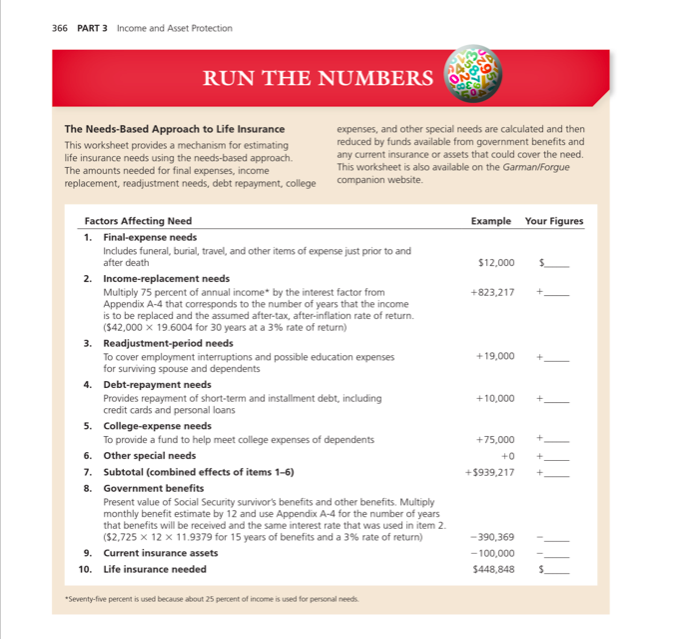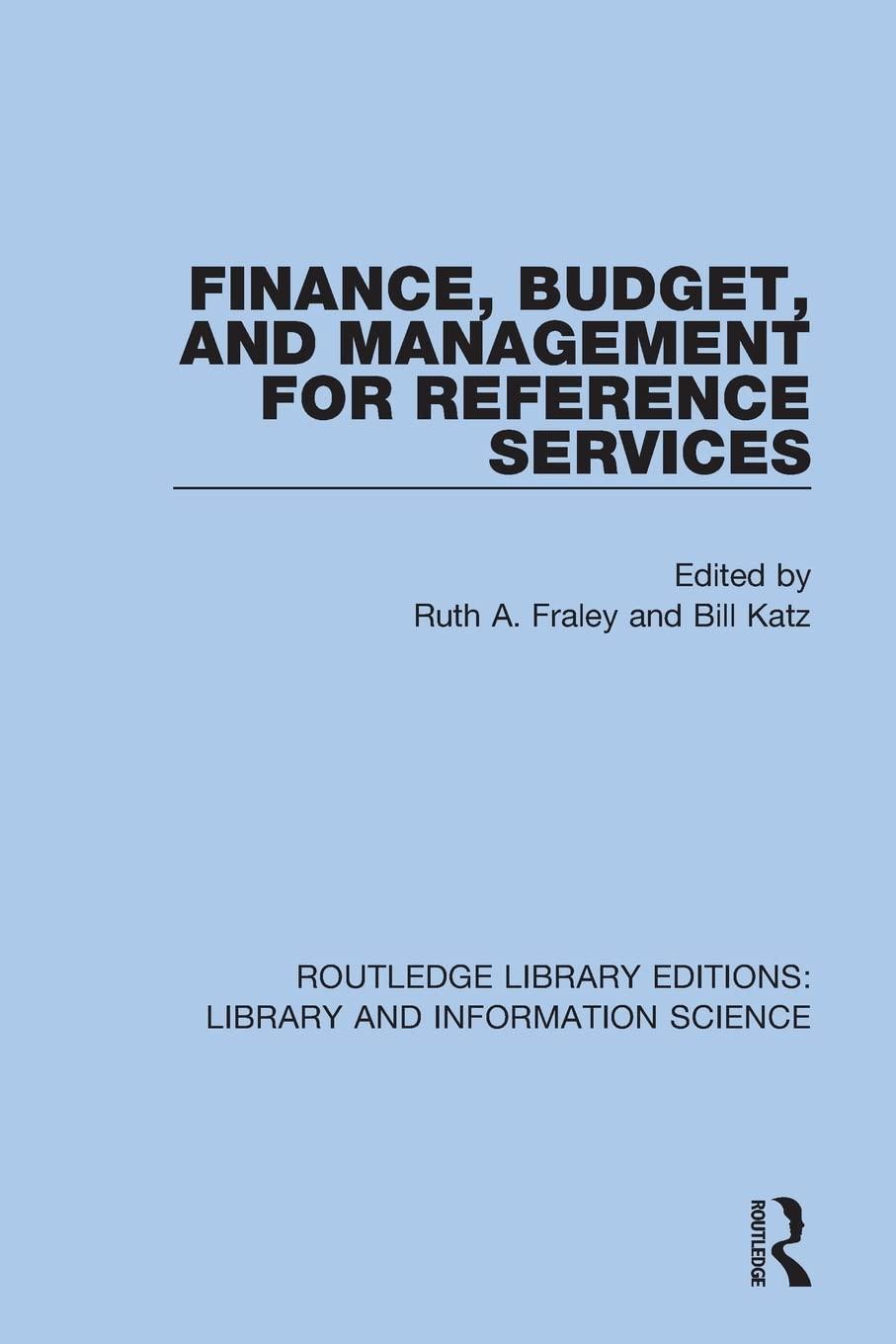Question
The Johnsons Change Their Life Insurance Coverage Harry and Belinda Johnson spend $20 per month on life insurance in the form of a premium on

The Johnsons Change Their Life Insurance Coverage
Harry and Belinda Johnson spend $20 per month on life insurance in the form of a premium on a $10,000, paid-at-65 cash-value policy on Harry that his parents bought for him years ago. Belinda has a group term insurance policy from her employer with a face amount of $200,000. By choosing a group life insurance plan from his menu of employee benefits, Harry now has $100,000 of group term life insurance. Harry and Belinda have decided that, because they have no children, they could reduce their life insurance needs by protecting one anothers income for only four years, assuming the survivor would be able to fend for himself or herself after that time. They also realize that their savings fund is so low that it would have no bearing on their life insurance needs. Harry and Belinda are basing their calculations on a projected 4 percent rate of return after taxes and inflation. They also estimate the following expenses: $15,000 for final expenses, $20,000 for readjustment expenses, and $5,000 for repayment of short-term debts.
a) Should the $3,000 interest earnings from Harrys trust fund be included in his annual income for the purposes of calculating the likely dollar loss if he were to die? Explain your response.
b) Based on your response to the previous question, how much more life insurance does Harry need? Use the Run the Numbers worksheet on page 366 to arrive at your answer.
c) Repeat the calculations to arrive at the additional life insurance needed on Belindas life.
d) How might the Johnsons most economically meet any additional life insurance needs you have determined they may have?
e) In addition to their life insurance planning, how might the Johnsons begin to prepare for their retirement years?
366 PART 3 Income and Asset Protection RUN THE NUMBERS The Needs-Based Approach to Life Insurance This worksheet provides a mechanism for estimating life insurance needs using the needs-based approach. The amounts needed for final expenses, income replacement, readjustment needs, debt repayment, college expenses, and other special needs are calculated and then reduced by funds available from government benefits and any current insurance or assets that could cover the need. This worksheet is also available on the Garman/Forgue companion website Example Your Figures $12,000 $ +823,217 +_ +19,000 + Factors Affecting Need 1. Final-expense needs Includes funeral, burial, travel, and other items of expense just prior to and after death 2. Income-replacement needs Multiply 75 percent of annual income by the interest factor from Appendix A-4 that corresponds to the number of years that the income is to be replaced and the assumed after-tax, after-inflation rate of return (542,000 X 19.6004 for 30 years at a 3% rate of return) 3. Readjustment-period needs To cover employment interruptions and possible education expenses for surviving spouse and dependents 4. Debt-repayment needs Provides repayment of short-term and installment debt, including credit cards and personal loans 5. College-expense needs To provide a fund to help meet college expenses of dependents 6. Other special needs 7. Subtotal (combined effects of items 1-6) 8. Government benefits Present value of Social Security Survivor's benefits and other benefits. Multiply monthly benefit estimate by 12 and use Appendix A-4 for the number of years that benefits will be received and the same interest rate that was used in item 2. (52,725 x 12 x 11.9379 for 15 years of benefits and a 3% rate of return) 9. Current insurance assets 10. Life insurance needed +10,000 + +75.000 +0 +5939,217 + + +_ - 390,369 - 100,000 $448,848 $ Seventy-five percent is used because about 25 percent of income is used for personal needs 366 PART 3 Income and Asset Protection RUN THE NUMBERS The Needs-Based Approach to Life Insurance This worksheet provides a mechanism for estimating life insurance needs using the needs-based approach. The amounts needed for final expenses, income replacement, readjustment needs, debt repayment, college expenses, and other special needs are calculated and then reduced by funds available from government benefits and any current insurance or assets that could cover the need. This worksheet is also available on the Garman/Forgue companion website Example Your Figures $12,000 $ +823,217 +_ +19,000 + Factors Affecting Need 1. Final-expense needs Includes funeral, burial, travel, and other items of expense just prior to and after death 2. Income-replacement needs Multiply 75 percent of annual income by the interest factor from Appendix A-4 that corresponds to the number of years that the income is to be replaced and the assumed after-tax, after-inflation rate of return (542,000 X 19.6004 for 30 years at a 3% rate of return) 3. Readjustment-period needs To cover employment interruptions and possible education expenses for surviving spouse and dependents 4. Debt-repayment needs Provides repayment of short-term and installment debt, including credit cards and personal loans 5. College-expense needs To provide a fund to help meet college expenses of dependents 6. Other special needs 7. Subtotal (combined effects of items 1-6) 8. Government benefits Present value of Social Security Survivor's benefits and other benefits. Multiply monthly benefit estimate by 12 and use Appendix A-4 for the number of years that benefits will be received and the same interest rate that was used in item 2. (52,725 x 12 x 11.9379 for 15 years of benefits and a 3% rate of return) 9. Current insurance assets 10. Life insurance needed +10,000 + +75.000 +0 +5939,217 + + +_ - 390,369 - 100,000 $448,848 $ Seventy-five percent is used because about 25 percent of income is used for personal needsStep by Step Solution
There are 3 Steps involved in it
Step: 1

Get Instant Access to Expert-Tailored Solutions
See step-by-step solutions with expert insights and AI powered tools for academic success
Step: 2

Step: 3

Ace Your Homework with AI
Get the answers you need in no time with our AI-driven, step-by-step assistance
Get Started


